
Donald Polland
(1932-2003)
Born in Los Angeles, Donald Polland became a sculptor of miniature cowboys and horses at a time when large size works of those themes were much more popular.
His interest in horses was aroused when, at age 15, he became a stable boy on a thoroughbred horse farm. He was a jockey for two years and held other jobs including that of electrician, farmer, commercial artist and teacher. He also studied foundry work and in 1966, began his four to six inch miniature bronzes, loving the ability to hold his work in one hand.
Source: Timber Stand Gallery

Wanted
Artist: Donald Polland (1932-2003)
Description: Bronze (1970) | Dimensions: 4 ½”h x 3 ½”w x 3 ¼”d; Edition #16 of 50bronze
In “Wanted” a lawbreaker stops to read a sign outside of the town he’d like to enter. If it’s his picture he sees on it, he’ll be movin’ on to the next town to avoid the risk of being recognized and potentially apprehended.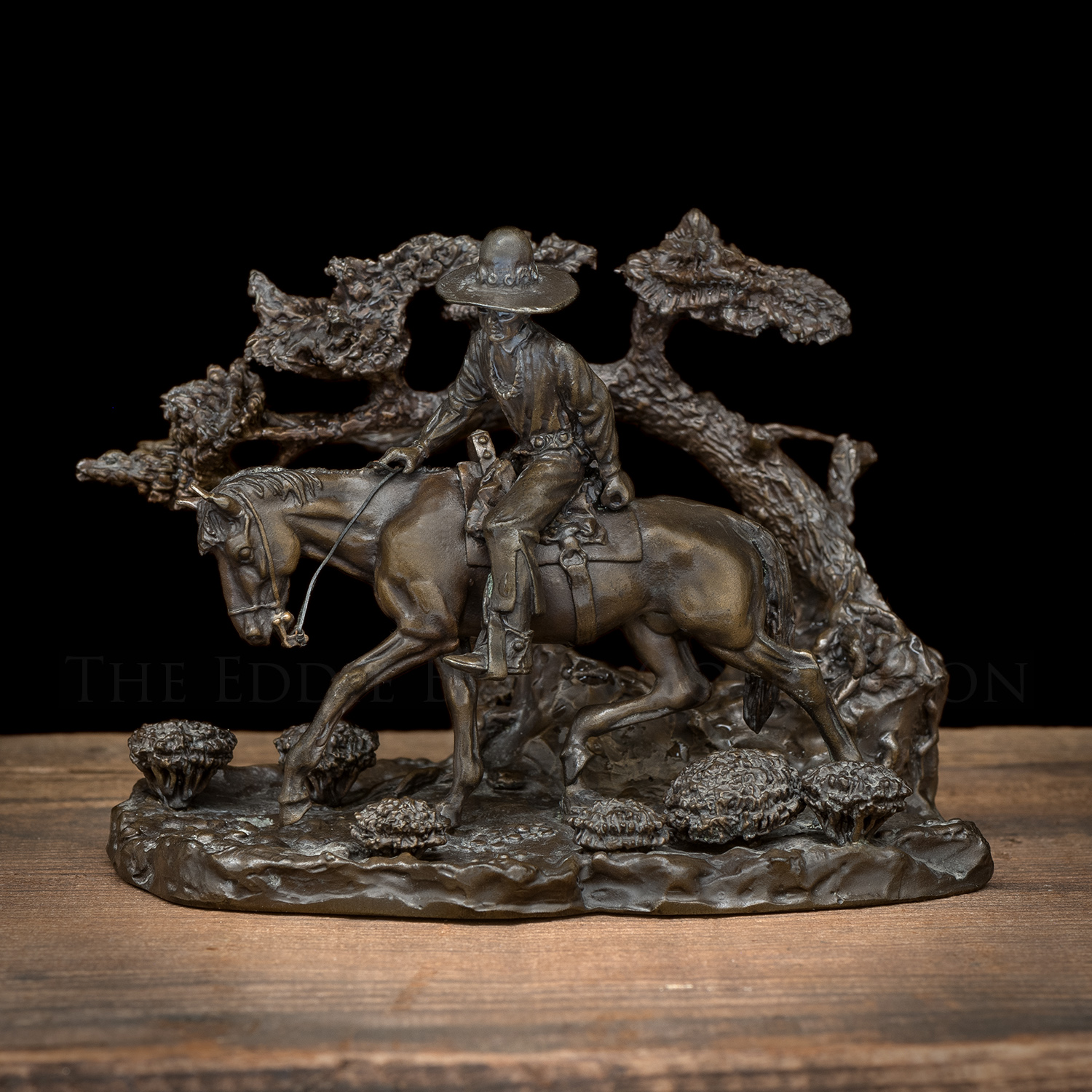
Going to the Sing
Artist: Donald Polland (1932-2003)
Description: Bronze (1971) | Dimensions: 3 ½”h x 4 ½”w x 4”d; Edition #9 of 40bronze
Don Polland once again captured the beautiful spirit of a Navajo rider astride his horse and dressed in his traditional attire on his way to a “sing”, a social gathering which may consist of song, dance and community. Culturally significant in most American Indian societies, participation is considered a personal responsibility, one which connotes respect for culture, tradition, community, family and self.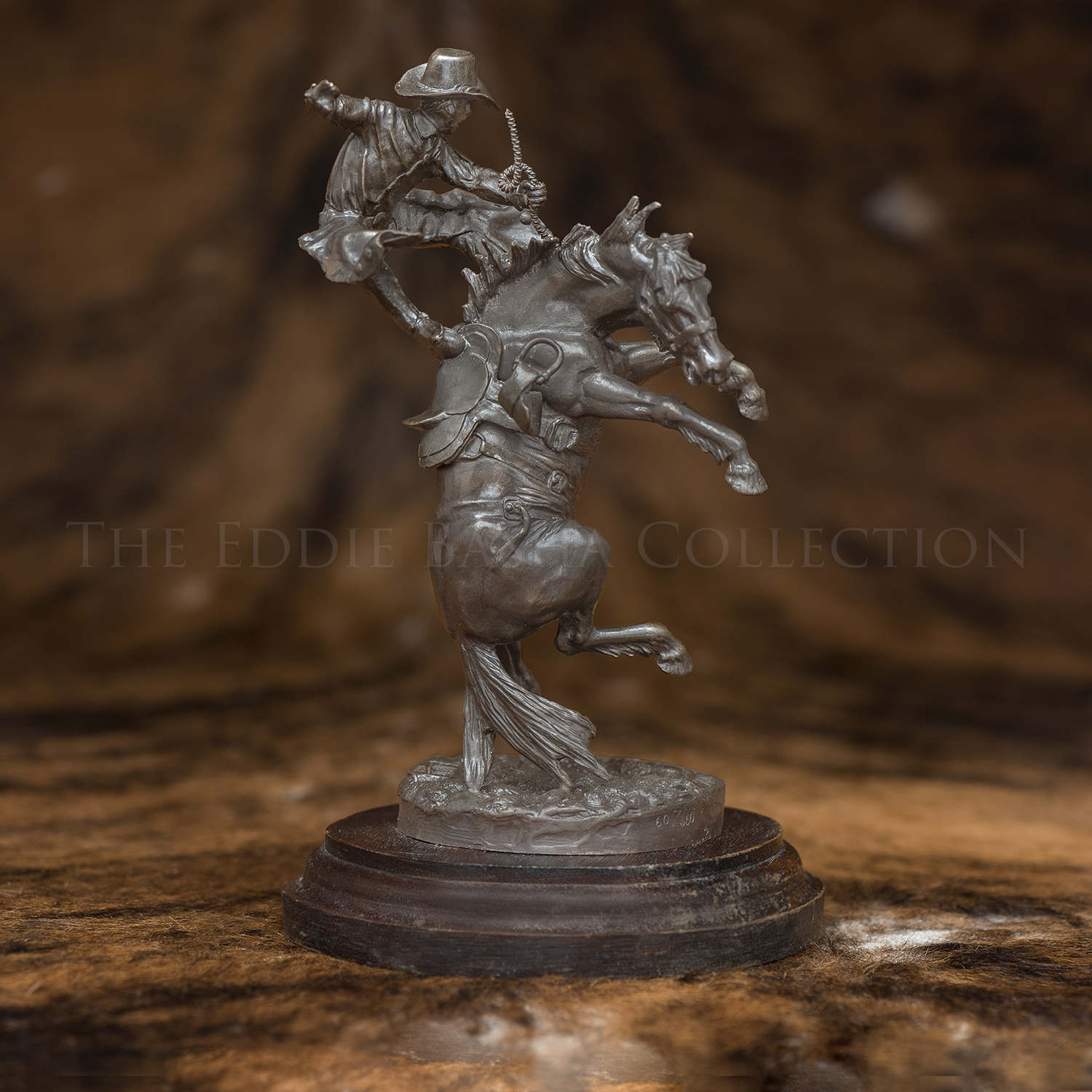
Saddle Bronc Rider
Artist: Donald Polland (1932-2003)
Description: Bronze (1978) | Dimensions: 6 ½”h x 4”w x 4”d; Edition #60 of 350bronze
The final miniature bronze in the Don Polland “Seven Events of Rodeo” series is “Saddle Bronc Rider”. Polland nailed the poetry in motion aspects of this rodeo classic event!
The PRCA Website https://prorodeo.com/prorodeo/rodeo/rodeo101/saddle-bronc-riding shares some excellent information and a wonderful video regarding scoring, style, grace and the nature of the precise timing elements of saddle bronc riding.
Header and Heeler or Team Roping (Seven Events of Rodeo Series)
Artist: Donald Polland (1932-2003)
Description: Bronze (1978) | Dimensions: 4”h x 13”w x 7”dbronze
In “The Seven Events of Rodeo” miniature bronze series created by Don Polland, “Header and Heeler” or “Team Roping” features the first roper, or header, who ropes the front of the steer and then wraps his rope around his saddle horn prior to using his horse to turn the steer to the left. Then, the second roper, or heeler, ropes the steer by its hind feet. A penalty is assessed if only one of the legs is caught. Team Roping is the only event were men and women compete equally together in sanctioned competition in either single or mixed gender teams.
Calf Roper (Seven Events of Rodeo Series)
Artist: Donald Polland (1932-2003)
Description: Bronze (1978) | Dimensions: 4”h x 13”w x 4”d; Edition #60 of 350bronze
In “The Seven Events of Rodeo” miniature bronze series created by Don Polland, “Calf Roper” features a calf and a rider dismounting his horse. The event was derived from working ranches wherein calves were caught and restrained for branding and medical treatment. The goal of the rodeo event is ultimately speed, however, participants must throw their lariats around the calf’s neck while riding at a breakneck pace.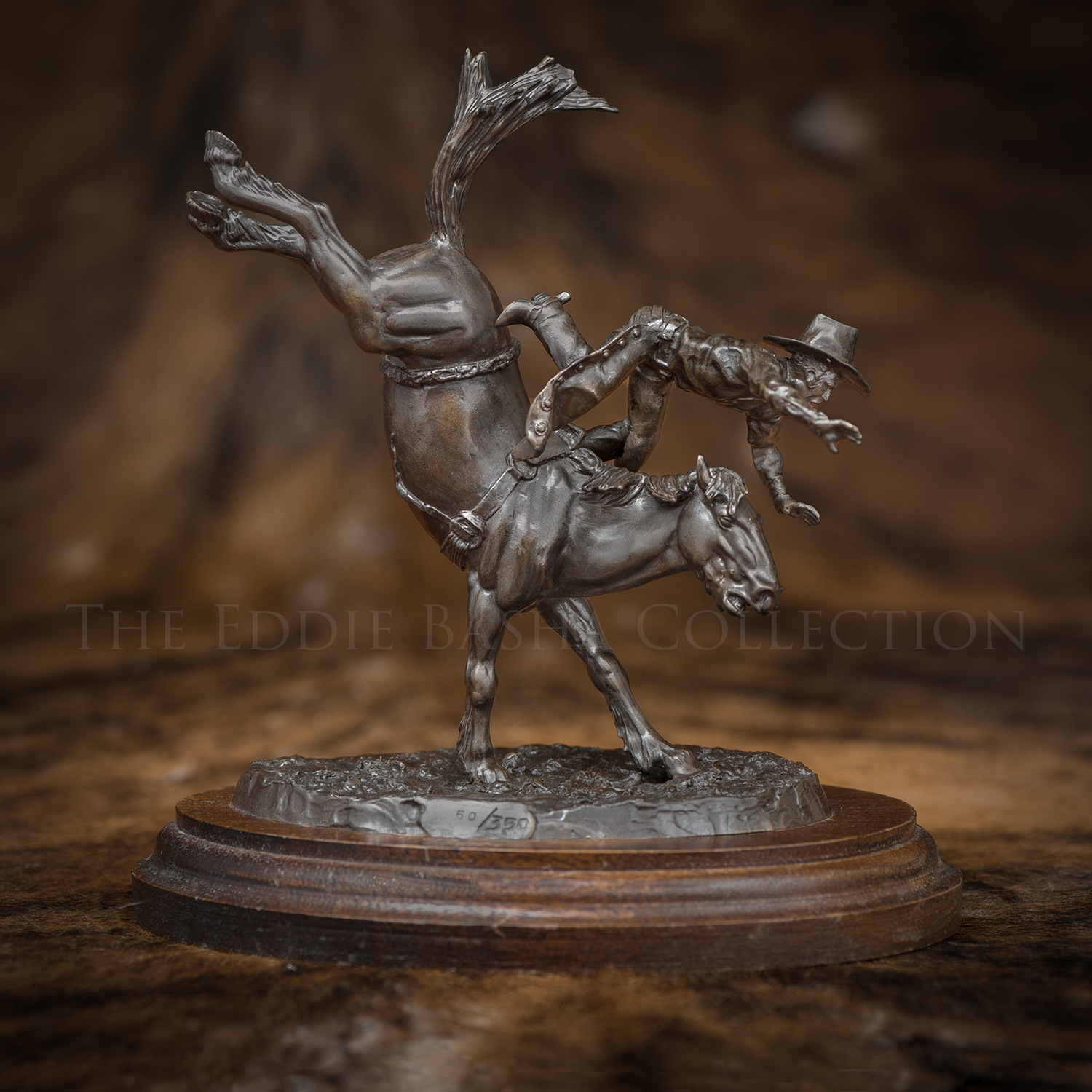
Bareback Rider (Seven Events of Rodeo Series)
Artist: Donald Polland (1932-2003)
Description: Bronze (1978) | Dimensions: 5”h x 5”w x 3”d; Edition #60 of 350bronze
Another in the rodeo series by Don Polland, Bareback Rider. Riding a bronc bareback isn’t for the faint of heart. It is one of the more physically demanding rodeo events and has a high injury rate. Cowboys must ride one-handed and cannot touch or hang onto anything with their free hand for a full eight seconds if they want the ride judged and scored. Once the eight second ride has completed, the cowboy can then use both hands until pickup riders helps them safely off the bronc. Judging takes into account the control and technique of the rider as well as the power, speed and agility of the horse. The scores are then combined to make the total. The highest possible score is 100.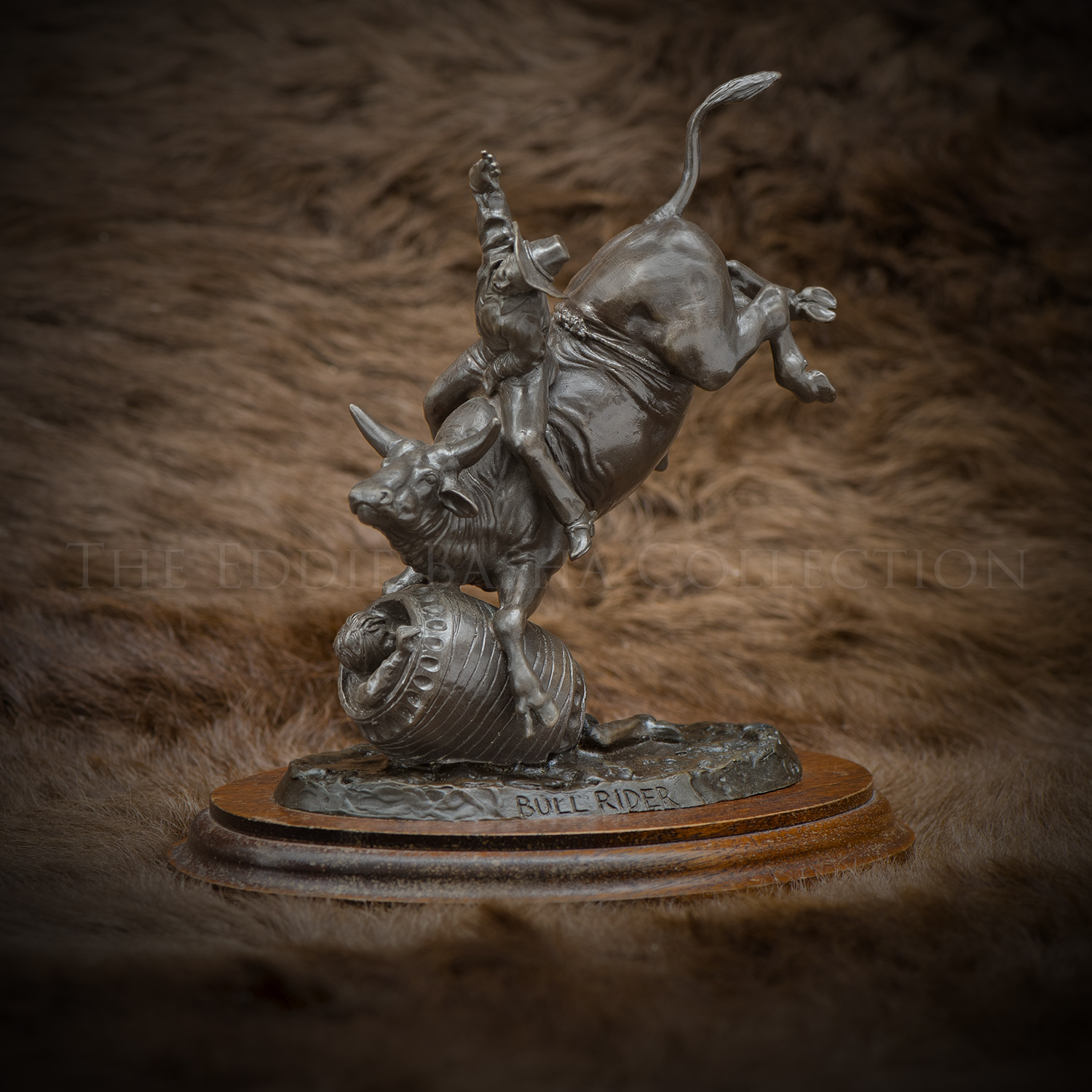
Bull Rider (Seven Events of Rodeo Series)
Artist: Donald Polland (1932-2003)
Description: Bronze | Dimensions: 6”h x 5”w x 4”d; Edition #60 of 350bronze
“Bull Rider” is another bronze in “The Seven Events of Rodeo” 1978 series by Don Polland.
American bull riding has been called "the most dangerous eight seconds in sports." To receive a score, the rider must stay on top of the bull for eight seconds with the use of one hand gripped on a bull rope tied behind the bull's forelegs. Touching the bull or themselves with the free hand, or failing to reach the eight-second mark, results in a no-score ride. Depending on the bull riding organization and the contest, up to four judges might judge the rider and four judge the bull on their performance. For most organizations, a perfect score is 100 points. In general, most professional riders score in the neighborhood of the mid-70s to the high 80s.
Outside of the United States, bull riding traditions with varying rules and histories exist in Canada, Mexico, Belize, Guatemala, El Salvador, Honduras, Nicaragua, Costa Rica, Panama, Cuba, the Dominican Republic, Colombia, Venezuela, Guyana, Ecuador, Peru, Bolivia, Brazil, Paraguay, Chile, Argentina, Uruguay, the Philippines, Japan, South Africa, England, Germany, France, Italy, Spain, Portugal, Australia and New Zealand with the majority of them following similar rules, especially with the Professional Bull Riders (PBR) organization.
Source: Wikipedia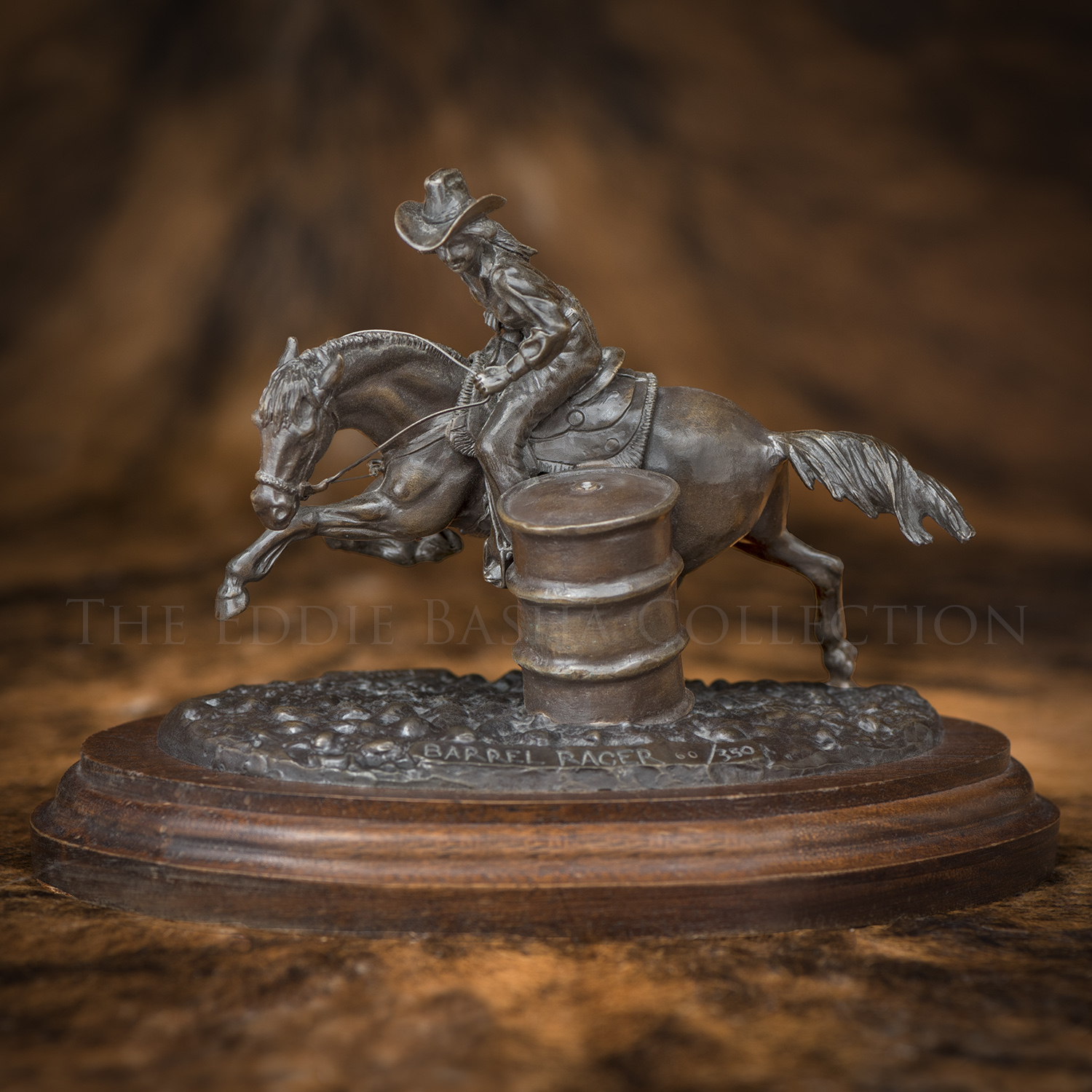
Barrel Racer (Seven Events of Rodeo Series)
Artist: Donald Polland (1932-2003)
Description: Bronze | Dimensions: 5”h x 7”w x 5 ½”d; Edition #60 of 350bronze
Enjoy another of the 1978 Don Polland “The Seven Events of Rodeo” bronze series … “Barrel Racer”.
Per Wikipedia, Barrel racing is a rodeo event in which a horse and rider attempt to run a cloverleaf pattern around preset barrels in the fastest time. Though both sexes compete at amateur and youth levels, in collegiate and professional ranks, it is usually a women's event. It requires a combination of the horse's athletic ability and the horsemanship skills of a rider in order to safely and successfully maneuver the horse around three barrels placed in a triangle pattern within a large arena.
Barrel racing originally developed as an event for women. In early barrel racing, the pattern alternated between a figure-eight and a cloverleaf pattern. The figure-eight was eventually dropped in favor of the more difficult cloverleaf.
It is believed that competitive barrel racing was first held in Texas. The Women's Professional Rodeo Association (WPRA) was founded in 1948 by a group of women from Texas who were trying to find a place for women in the wider sport of rodeo. When it began, the WPRA was called the Girls Rodeo Association (GRA). It consisted of 74 members, with about 60 approved tour events. The Girls Rodeo Association was the first body of rodeo developed specifically for women. The GRA changed its name to Women's Professional Rodeo Association in 1981, and the WPRA still provides women competition opportunities in several rodeo events, but barrel racing remains the most popular.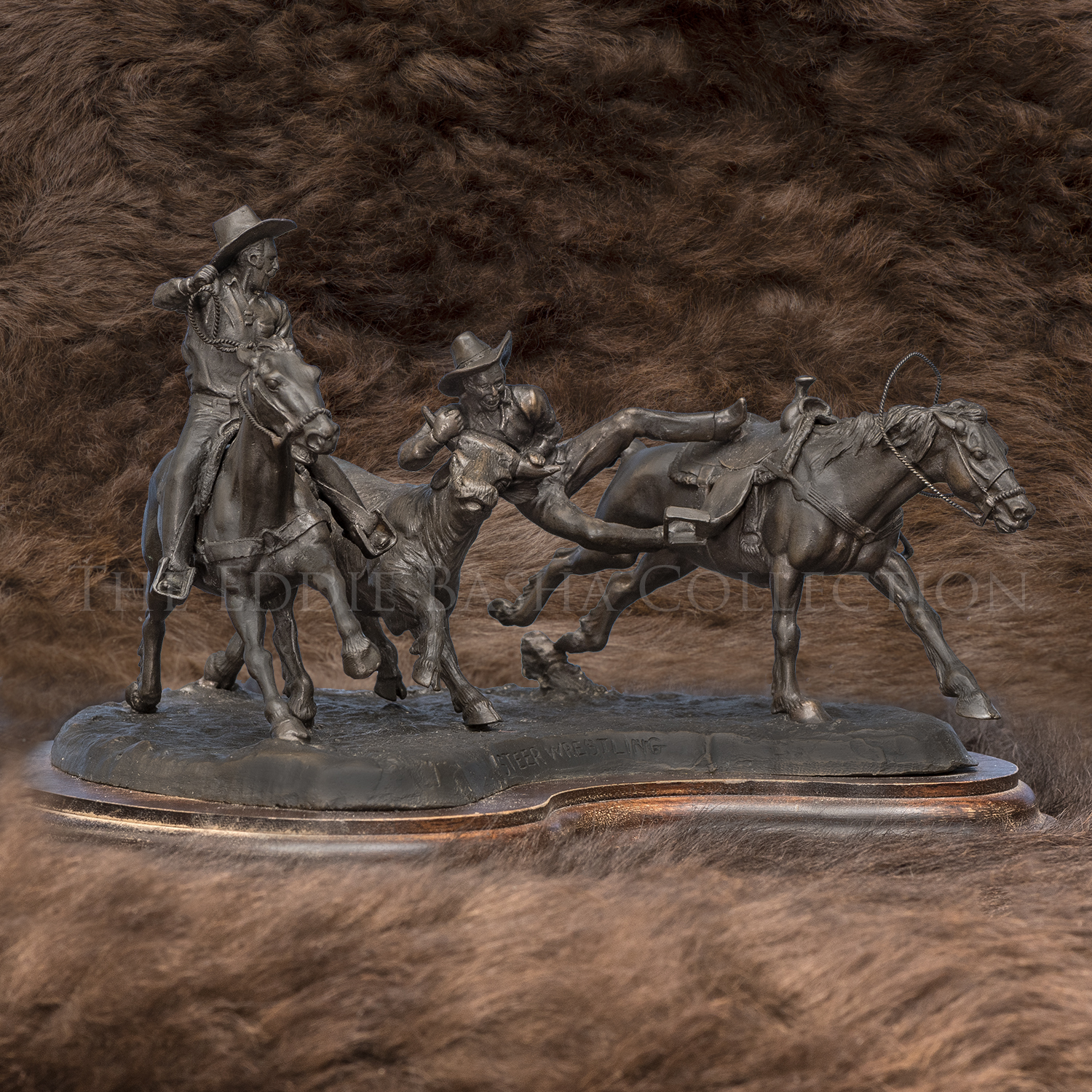
Steer Wrestling (Seven Events of Rodeo Series)
Artist: Donald Polland (1932-2003)
Description: Bronze | Dimensions: 7”h x 8”w x 5”d; Edition #60 of 350bronze
In 1978, Don Polland began a miniature series of bronze pieces entitled “The Seven Events of Rodeo” of which “Steer Wrestling” is one piece within the series. Each within the series is titled, bears the artist’s signature, the year and its edition number. And though Polland’s bronzes are quite small, they contain myriad detail and realistic touches that show his familiarity with his subject matter.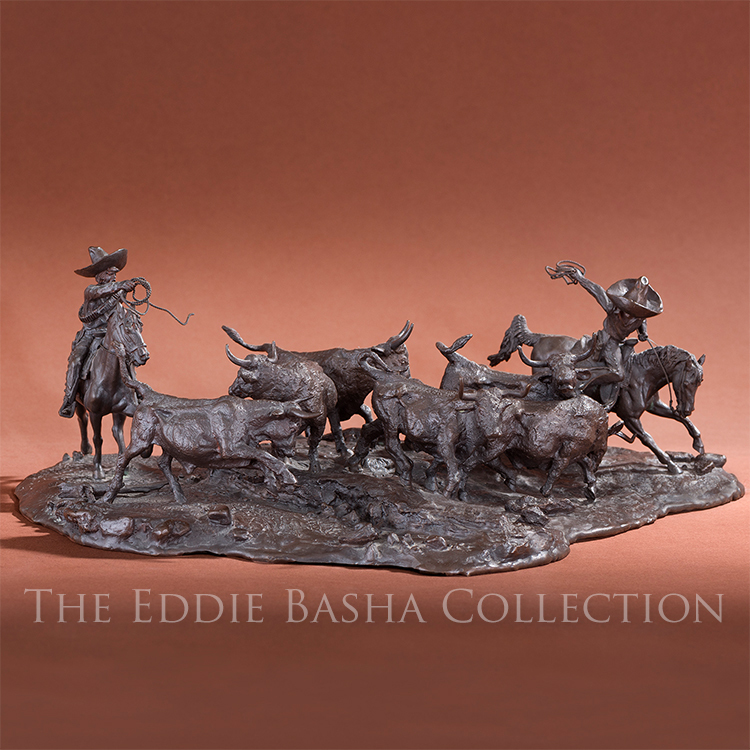
Border Rustlers
Artist: Donald Polland (1932-2003)
Description: Bronze (Miniature) | Dimensions: 5”h x 13”w x 8’d; Edition #10 of 60bronze
This scene was played out often in the wild, rugged west by an unscrupulous cast of characters.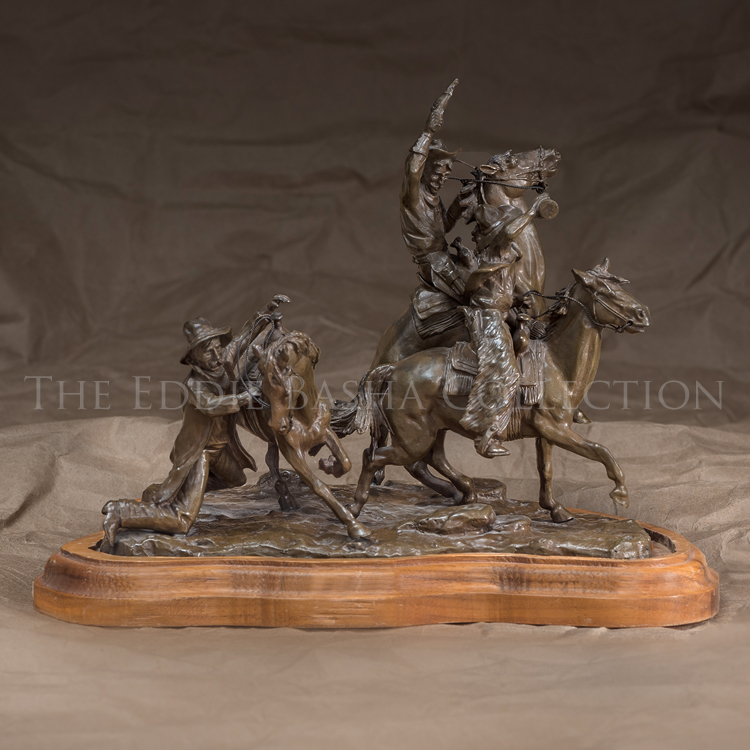
Paintin’ the Town
Artist: Donald Polland (1932-2003)
Description: Bronze (1975) | 5”h x 6”w; Edition #2 of 6bronze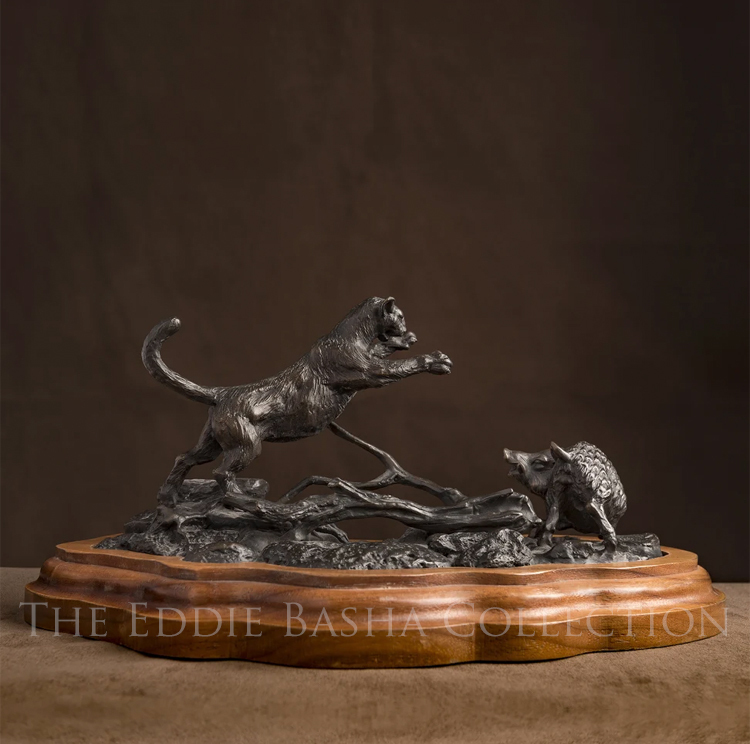
Looking for Trouble
Artist: Donald Polland (1932-2003)
Description: Bronze (1976) | Dimensions: 3 ½”h X 6 ½”w X 4”d; Edition #15 of 35bronze
Small bronzes were a specialty of Donald Polland, and though small in size they are no less detailed than a larger bronze. “Looking for Trouble” is an excellent study of western wildlife. Mountain Lion often prey upon javelina though not always successfully. Javelina won’t necessarily back down nor run away since they have a tendency to travel in large family packs and are well equipped to fight with their long, sharp and protruding canine teeth.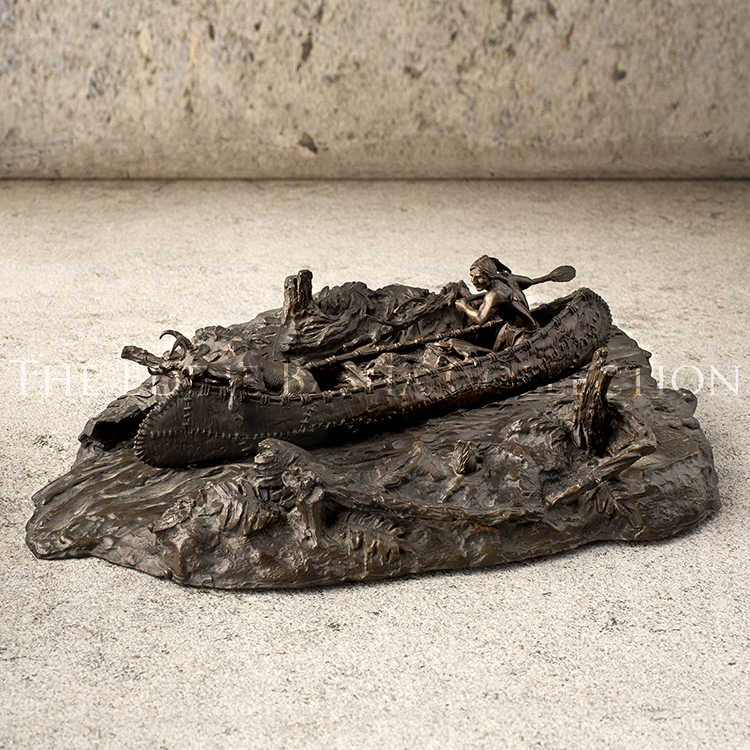
His Land
Artist: Donald Polland (1932-2003)
Description: Bronze (1975) | 3”h X 7”d x 10”w; Edition #21 of 50bronze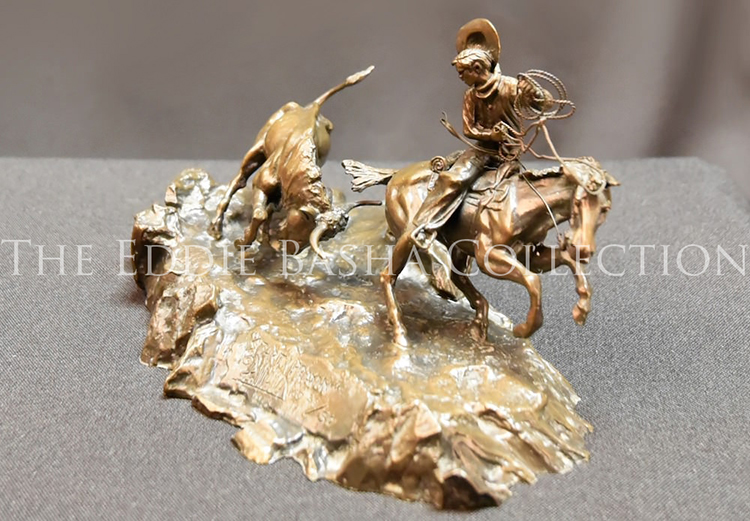
Start Prayin'
Artist: Donald Polland (1932-2003)
Description: Bronze (1969) | 4” x 5” x 7”; Edition #39 of 50bronze
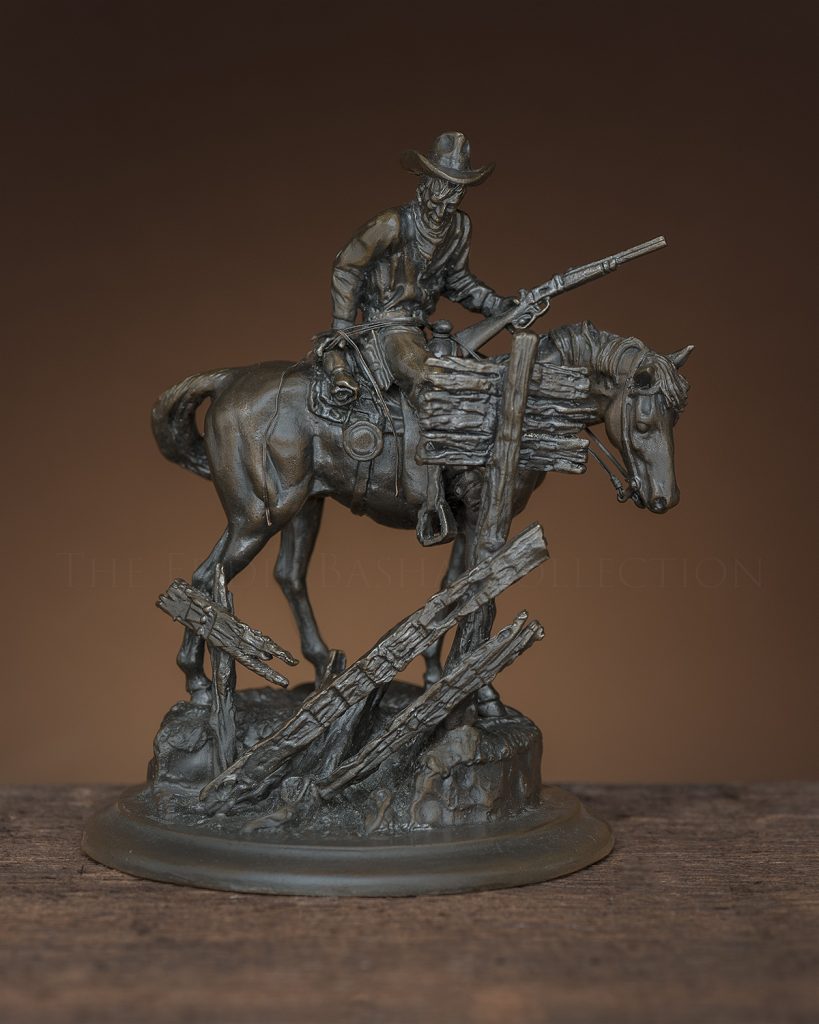 Bronze (1970) | Dimensions: 4 ½”h x 3 ½”w x 3 ¼”d; Edition #16 of 50
Bronze (1970) | Dimensions: 4 ½”h x 3 ½”w x 3 ¼”d; Edition #16 of 50In “Wanted” a lawbreaker stops to read a sign outside of the town he’d like to enter. If it’s his picture he sees on it, he’ll be movin’ on to the next town to avoid the risk of being recognized and potentially apprehended.
Wanted
Artist: Donald Polland (1932-2003)
Description:
Bronze (1970) | Dimensions: 4 ½”h x 3 ½”w x 3 ¼”d; Edition #16 of 50
In “Wanted” a lawbreaker stops to read a sign outside of the town he’d like to enter. If it’s his picture he sees on it, he’ll be movin’ on to the next town to avoid the risk of being recognized and potentially apprehended.
bronzeIn “Wanted” a lawbreaker stops to read a sign outside of the town he’d like to enter. If it’s his picture he sees on it, he’ll be movin’ on to the next town to avoid the risk of being recognized and potentially apprehended.
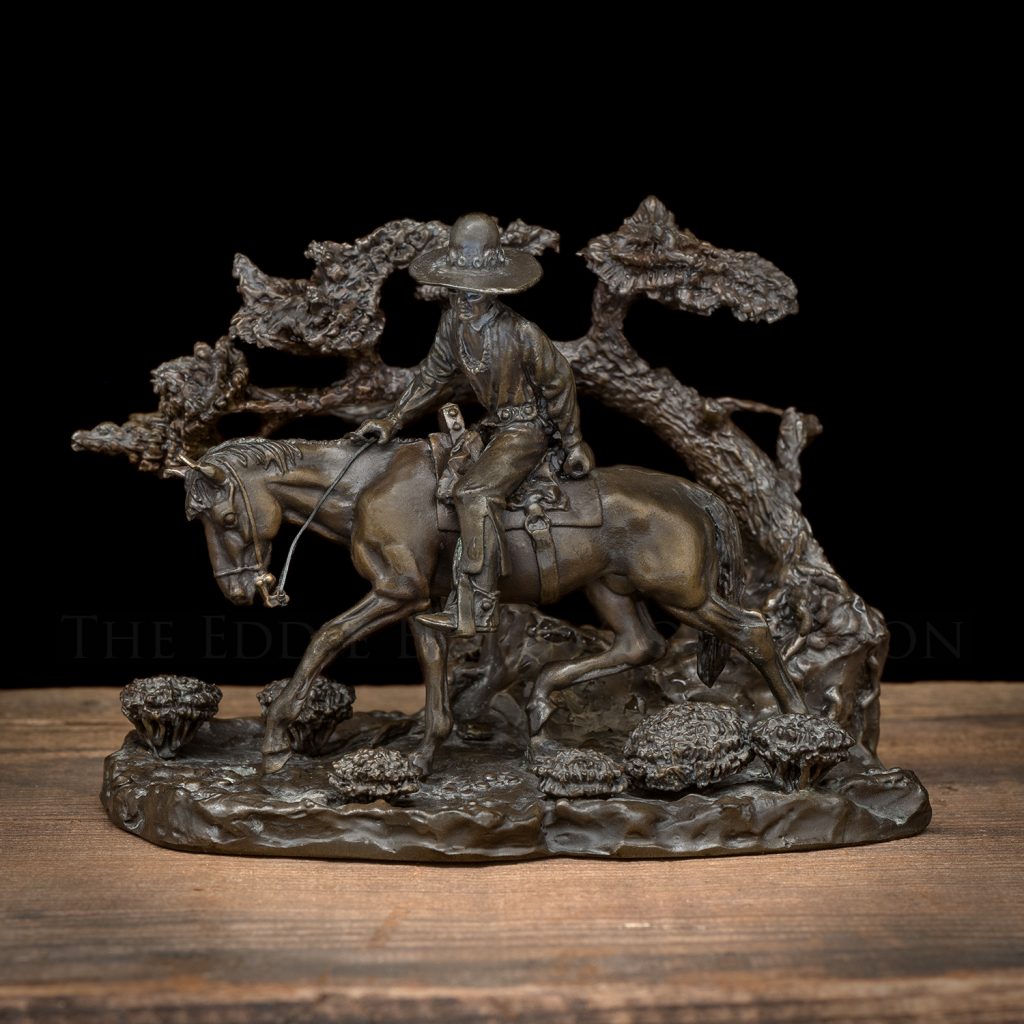 Bronze (1971) | Dimensions: 3 ½”h x 4 ½”w x 4”d; Edition #9 of 40
Bronze (1971) | Dimensions: 3 ½”h x 4 ½”w x 4”d; Edition #9 of 40Don Polland once again captured the beautiful spirit of a Navajo rider astride his horse and dressed in his traditional attire on his way to a “sing”, a social gathering which may consist of song, dance and community. Culturally significant in most American Indian societies, participation is considered a personal responsibility, one which connotes respect for culture, tradition, community, family and self.
Going to the Sing
Artist: Donald Polland (1932-2003)
Description:
Bronze (1971) | Dimensions: 3 ½”h x 4 ½”w x 4”d; Edition #9 of 40
Don Polland once again captured the beautiful spirit of a Navajo rider astride his horse and dressed in his traditional attire on his way to a “sing”, a social gathering which may consist of song, dance and community. Culturally significant in most American Indian societies, participation is considered a personal responsibility, one which connotes respect for culture, tradition, community, family and self.
bronzeDon Polland once again captured the beautiful spirit of a Navajo rider astride his horse and dressed in his traditional attire on his way to a “sing”, a social gathering which may consist of song, dance and community. Culturally significant in most American Indian societies, participation is considered a personal responsibility, one which connotes respect for culture, tradition, community, family and self.
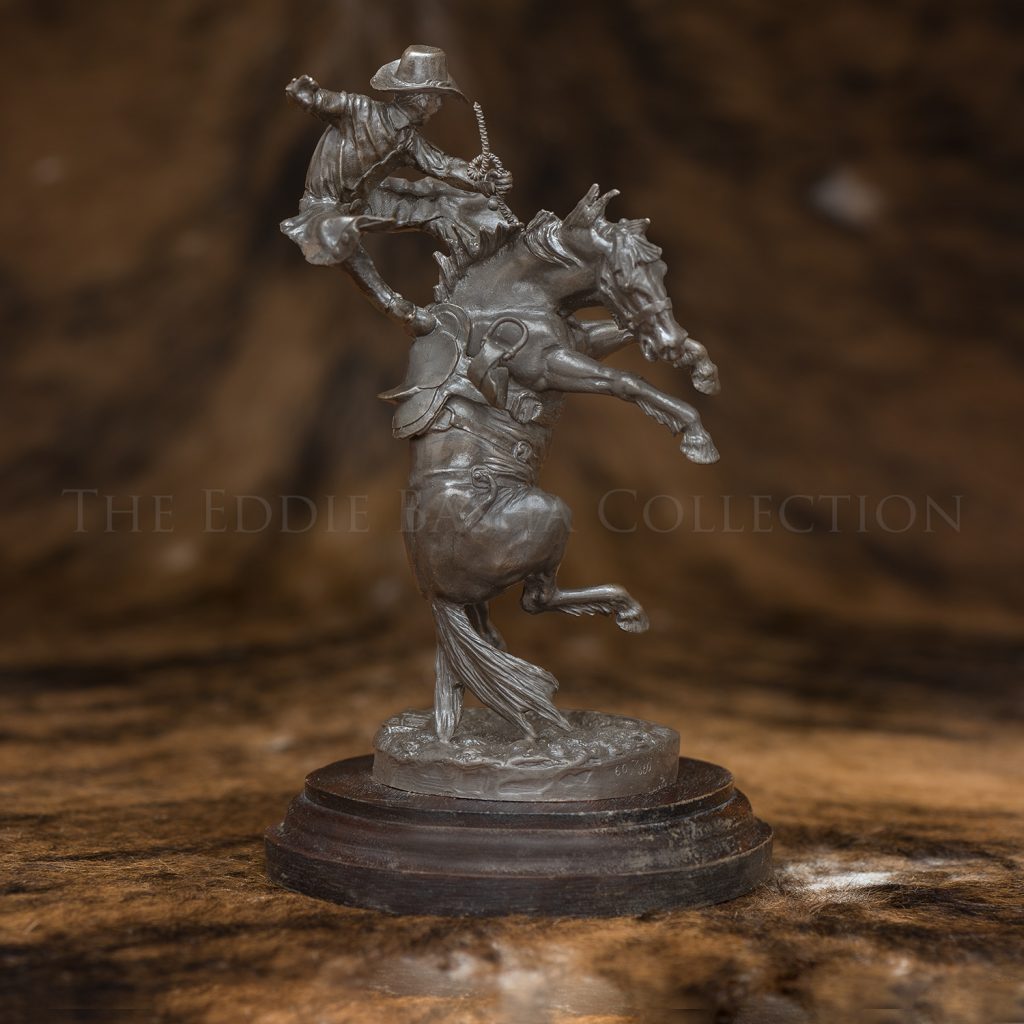 Bronze (1978) | Dimensions: 6 ½”h x 4”w x 4”d; Edition #60 of 350
Bronze (1978) | Dimensions: 6 ½”h x 4”w x 4”d; Edition #60 of 350 The final miniature bronze in the Don Polland “Seven Events of Rodeo” series is “Saddle Bronc Rider”. Polland nailed the poetry in motion aspects of this rodeo classic event!
The PRCA Website https://prorodeo.com/prorodeo/rodeo/rodeo101/saddle-bronc-riding shares some excellent information and a wonderful video regarding scoring, style, grace and the nature of the precise timing elements of saddle bronc riding.
Saddle Bronc Rider
Artist: Donald Polland (1932-2003)
Description:
Bronze (1978) | Dimensions: 6 ½”h x 4”w x 4”d; Edition #60 of 350
The final miniature bronze in the Don Polland “Seven Events of Rodeo” series is “Saddle Bronc Rider”. Polland nailed the poetry in motion aspects of this rodeo classic event!
The PRCA Website https://prorodeo.com/prorodeo/rodeo/rodeo101/saddle-bronc-riding shares some excellent information and a wonderful video regarding scoring, style, grace and the nature of the precise timing elements of saddle bronc riding.
bronzeThe final miniature bronze in the Don Polland “Seven Events of Rodeo” series is “Saddle Bronc Rider”. Polland nailed the poetry in motion aspects of this rodeo classic event!
The PRCA Website https://prorodeo.com/prorodeo/rodeo/rodeo101/saddle-bronc-riding shares some excellent information and a wonderful video regarding scoring, style, grace and the nature of the precise timing elements of saddle bronc riding.
 Bronze (1978) | Dimensions: 4”h x 13”w x 7”d
Bronze (1978) | Dimensions: 4”h x 13”w x 7”dIn “The Seven Events of Rodeo” miniature bronze series created by Don Polland, “Header and Heeler” or “Team Roping” features the first roper, or header, who ropes the front of the steer and then wraps his rope around his saddle horn prior to using his horse to turn the steer to the left. Then, the second roper, or heeler, ropes the steer by its hind feet. A penalty is assessed if only one of the legs is caught. Team Roping is the only event were men and women compete equally together in sanctioned competition in either single or mixed gender teams.
Header and Heeler or Team Roping (Seven Events of Rodeo Series)
Artist: Donald Polland (1932-2003)
Description:
Bronze (1978) | Dimensions: 4”h x 13”w x 7”d
In “The Seven Events of Rodeo” miniature bronze series created by Don Polland, “Header and Heeler” or “Team Roping” features the first roper, or header, who ropes the front of the steer and then wraps his rope around his saddle horn prior to using his horse to turn the steer to the left. Then, the second roper, or heeler, ropes the steer by its hind feet. A penalty is assessed if only one of the legs is caught. Team Roping is the only event were men and women compete equally together in sanctioned competition in either single or mixed gender teams.
bronzeIn “The Seven Events of Rodeo” miniature bronze series created by Don Polland, “Header and Heeler” or “Team Roping” features the first roper, or header, who ropes the front of the steer and then wraps his rope around his saddle horn prior to using his horse to turn the steer to the left. Then, the second roper, or heeler, ropes the steer by its hind feet. A penalty is assessed if only one of the legs is caught. Team Roping is the only event were men and women compete equally together in sanctioned competition in either single or mixed gender teams.
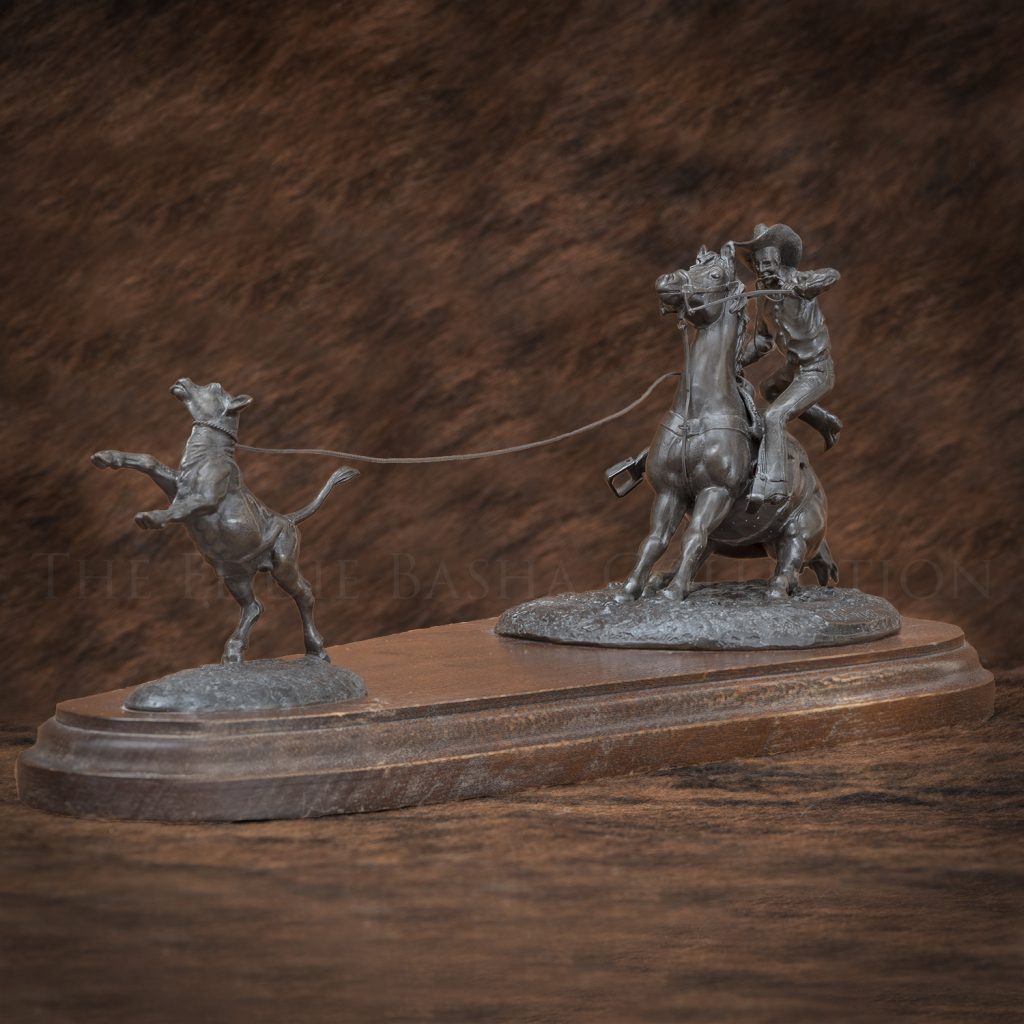 Bronze (1978) | Dimensions: 4”h x 13”w x 4”d; Edition #60 of 350
Bronze (1978) | Dimensions: 4”h x 13”w x 4”d; Edition #60 of 350In “The Seven Events of Rodeo” miniature bronze series created by Don Polland, “Calf Roper” features a calf and a rider dismounting his horse. The event was derived from working ranches wherein calves were caught and restrained for branding and medical treatment. The goal of the rodeo event is ultimately speed, however, participants must throw their lariats around the calf’s neck while riding at a breakneck pace.
Calf Roper (Seven Events of Rodeo Series)
Artist: Donald Polland (1932-2003)
Description:
Bronze (1978) | Dimensions: 4”h x 13”w x 4”d; Edition #60 of 350
In “The Seven Events of Rodeo” miniature bronze series created by Don Polland, “Calf Roper” features a calf and a rider dismounting his horse. The event was derived from working ranches wherein calves were caught and restrained for branding and medical treatment. The goal of the rodeo event is ultimately speed, however, participants must throw their lariats around the calf’s neck while riding at a breakneck pace.
bronzeIn “The Seven Events of Rodeo” miniature bronze series created by Don Polland, “Calf Roper” features a calf and a rider dismounting his horse. The event was derived from working ranches wherein calves were caught and restrained for branding and medical treatment. The goal of the rodeo event is ultimately speed, however, participants must throw their lariats around the calf’s neck while riding at a breakneck pace.
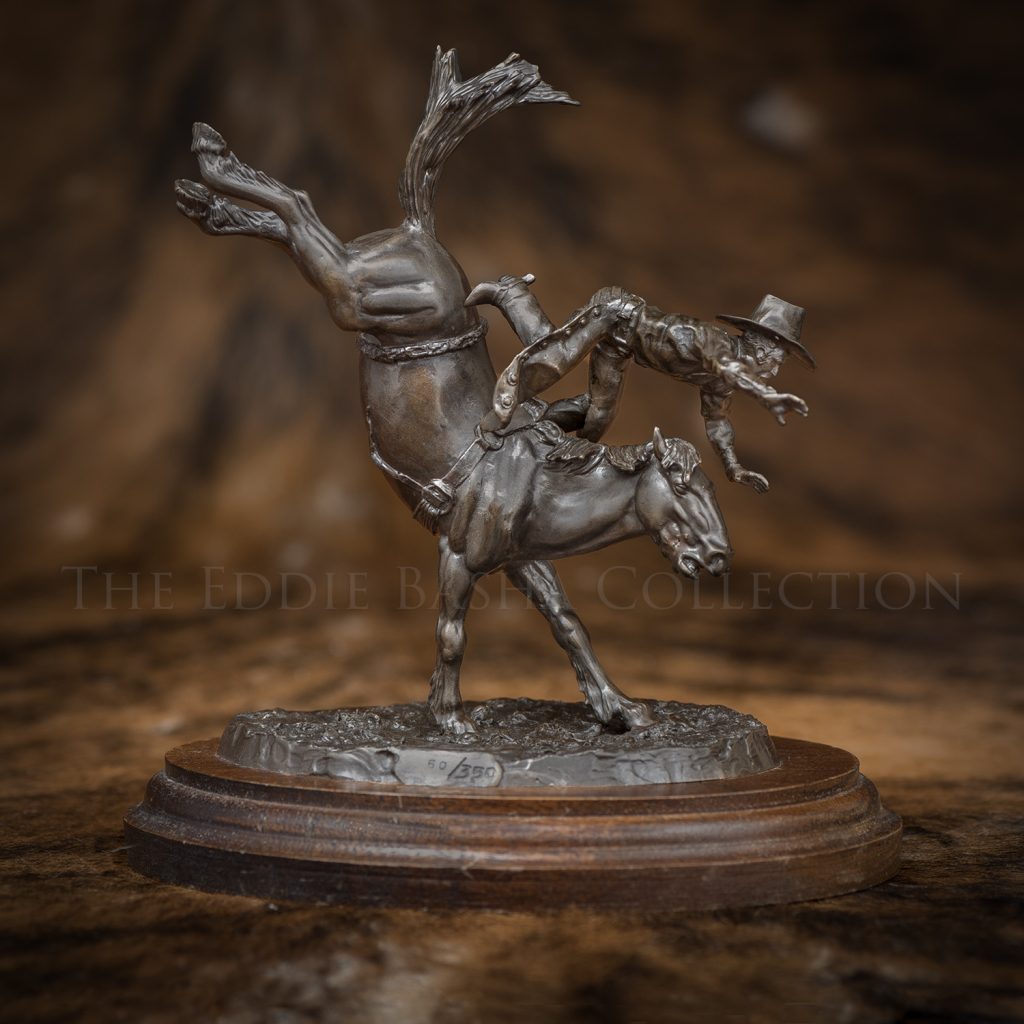 Bronze (1978) | Dimensions: 5”h x 5”w x 3”d; Edition #60 of 350
Bronze (1978) | Dimensions: 5”h x 5”w x 3”d; Edition #60 of 350Another in the rodeo series by Don Polland, Bareback Rider. Riding a bronc bareback isn’t for the faint of heart. It is one of the more physically demanding rodeo events and has a high injury rate. Cowboys must ride one-handed and cannot touch or hang onto anything with their free hand for a full eight seconds if they want the ride judged and scored. Once the eight second ride has completed, the cowboy can then use both hands until pickup riders helps them safely off the bronc. Judging takes into account the control and technique of the rider as well as the power, speed and agility of the horse. The scores are then combined to make the total. The highest possible score is 100.
Bareback Rider (Seven Events of Rodeo Series)
Artist: Donald Polland (1932-2003)
Description:
Bronze (1978) | Dimensions: 5”h x 5”w x 3”d; Edition #60 of 350
Another in the rodeo series by Don Polland, Bareback Rider. Riding a bronc bareback isn’t for the faint of heart. It is one of the more physically demanding rodeo events and has a high injury rate. Cowboys must ride one-handed and cannot touch or hang onto anything with their free hand for a full eight seconds if they want the ride judged and scored. Once the eight second ride has completed, the cowboy can then use both hands until pickup riders helps them safely off the bronc. Judging takes into account the control and technique of the rider as well as the power, speed and agility of the horse. The scores are then combined to make the total. The highest possible score is 100.
bronzeAnother in the rodeo series by Don Polland, Bareback Rider. Riding a bronc bareback isn’t for the faint of heart. It is one of the more physically demanding rodeo events and has a high injury rate. Cowboys must ride one-handed and cannot touch or hang onto anything with their free hand for a full eight seconds if they want the ride judged and scored. Once the eight second ride has completed, the cowboy can then use both hands until pickup riders helps them safely off the bronc. Judging takes into account the control and technique of the rider as well as the power, speed and agility of the horse. The scores are then combined to make the total. The highest possible score is 100.
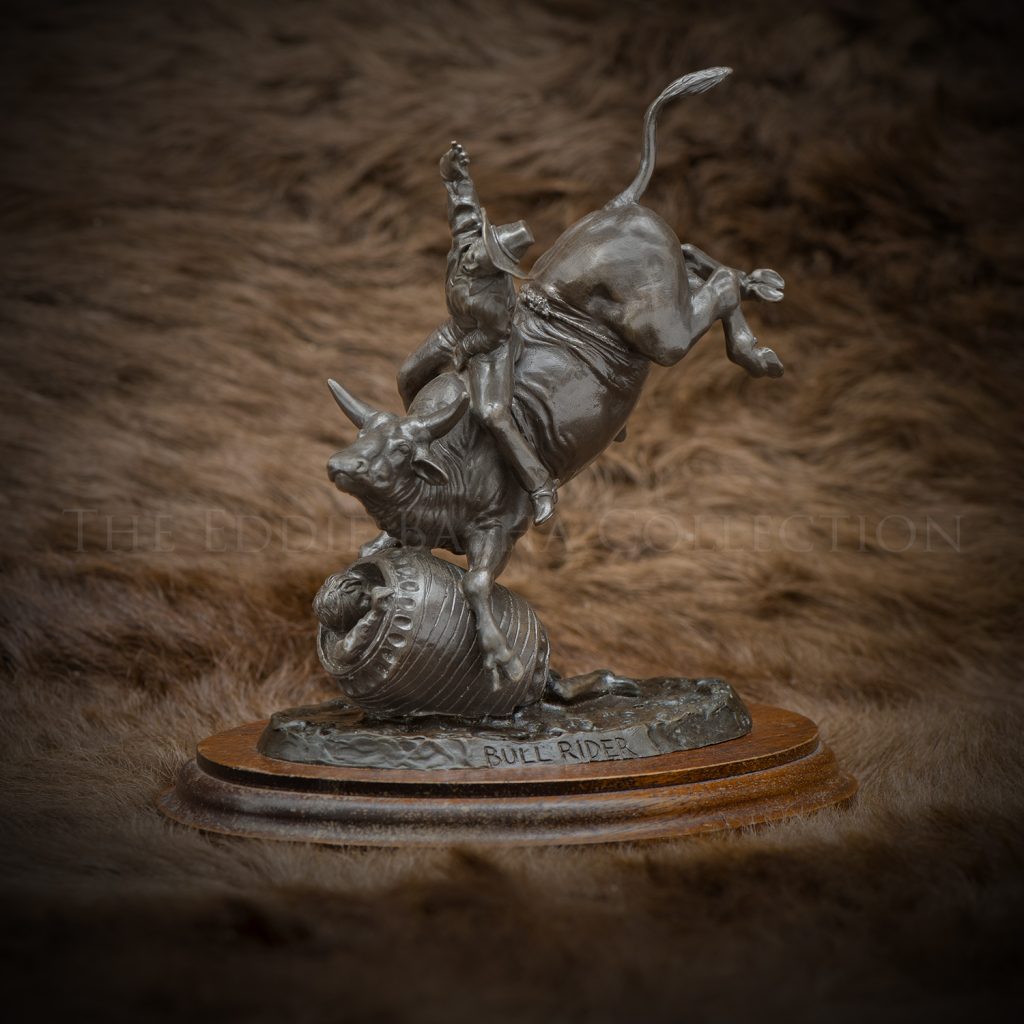 Bronze | Dimensions: 6”h x 5”w x 4”d; Edition #60 of 350
Bronze | Dimensions: 6”h x 5”w x 4”d; Edition #60 of 350“Bull Rider” is another bronze in “The Seven Events of Rodeo” 1978 series by Don Polland.
American bull riding has been called "the most dangerous eight seconds in sports." To receive a score, the rider must stay on top of the bull for eight seconds with the use of one hand gripped on a bull rope tied behind the bull's forelegs. Touching the bull or themselves with the free hand, or failing to reach the eight-second mark, results in a no-score ride. Depending on the bull riding organization and the contest, up to four judges might judge the rider and four judge the bull on their performance. For most organizations, a perfect score is 100 points. In general, most professional riders score in the neighborhood of the mid-70s to the high 80s.
Outside of the United States, bull riding traditions with varying rules and histories exist in Canada, Mexico, Belize, Guatemala, El Salvador, Honduras, Nicaragua, Costa Rica, Panama, Cuba, the Dominican Republic, Colombia, Venezuela, Guyana, Ecuador, Peru, Bolivia, Brazil, Paraguay, Chile, Argentina, Uruguay, the Philippines, Japan, South Africa, England, Germany, France, Italy, Spain, Portugal, Australia and New Zealand with the majority of them following similar rules, especially with the Professional Bull Riders (PBR) organization.
Source: Wikipedia
Bull Rider (Seven Events of Rodeo Series)
Artist: Donald Polland (1932-2003)
Description:
Bronze | Dimensions: 6”h x 5”w x 4”d; Edition #60 of 350
“Bull Rider” is another bronze in “The Seven Events of Rodeo” 1978 series by Don Polland.
American bull riding has been called "the most dangerous eight seconds in sports." To receive a score, the rider must stay on top of the bull for eight seconds with the use of one hand gripped on a bull rope tied behind the bull's forelegs. Touching the bull or themselves with the free hand, or failing to reach the eight-second mark, results in a no-score ride. Depending on the bull riding organization and the contest, up to four judges might judge the rider and four judge the bull on their performance. For most organizations, a perfect score is 100 points. In general, most professional riders score in the neighborhood of the mid-70s to the high 80s.
Outside of the United States, bull riding traditions with varying rules and histories exist in Canada, Mexico, Belize, Guatemala, El Salvador, Honduras, Nicaragua, Costa Rica, Panama, Cuba, the Dominican Republic, Colombia, Venezuela, Guyana, Ecuador, Peru, Bolivia, Brazil, Paraguay, Chile, Argentina, Uruguay, the Philippines, Japan, South Africa, England, Germany, France, Italy, Spain, Portugal, Australia and New Zealand with the majority of them following similar rules, especially with the Professional Bull Riders (PBR) organization.
Source: Wikipedia
bronze“Bull Rider” is another bronze in “The Seven Events of Rodeo” 1978 series by Don Polland.
American bull riding has been called "the most dangerous eight seconds in sports." To receive a score, the rider must stay on top of the bull for eight seconds with the use of one hand gripped on a bull rope tied behind the bull's forelegs. Touching the bull or themselves with the free hand, or failing to reach the eight-second mark, results in a no-score ride. Depending on the bull riding organization and the contest, up to four judges might judge the rider and four judge the bull on their performance. For most organizations, a perfect score is 100 points. In general, most professional riders score in the neighborhood of the mid-70s to the high 80s.
Outside of the United States, bull riding traditions with varying rules and histories exist in Canada, Mexico, Belize, Guatemala, El Salvador, Honduras, Nicaragua, Costa Rica, Panama, Cuba, the Dominican Republic, Colombia, Venezuela, Guyana, Ecuador, Peru, Bolivia, Brazil, Paraguay, Chile, Argentina, Uruguay, the Philippines, Japan, South Africa, England, Germany, France, Italy, Spain, Portugal, Australia and New Zealand with the majority of them following similar rules, especially with the Professional Bull Riders (PBR) organization.
Source: Wikipedia
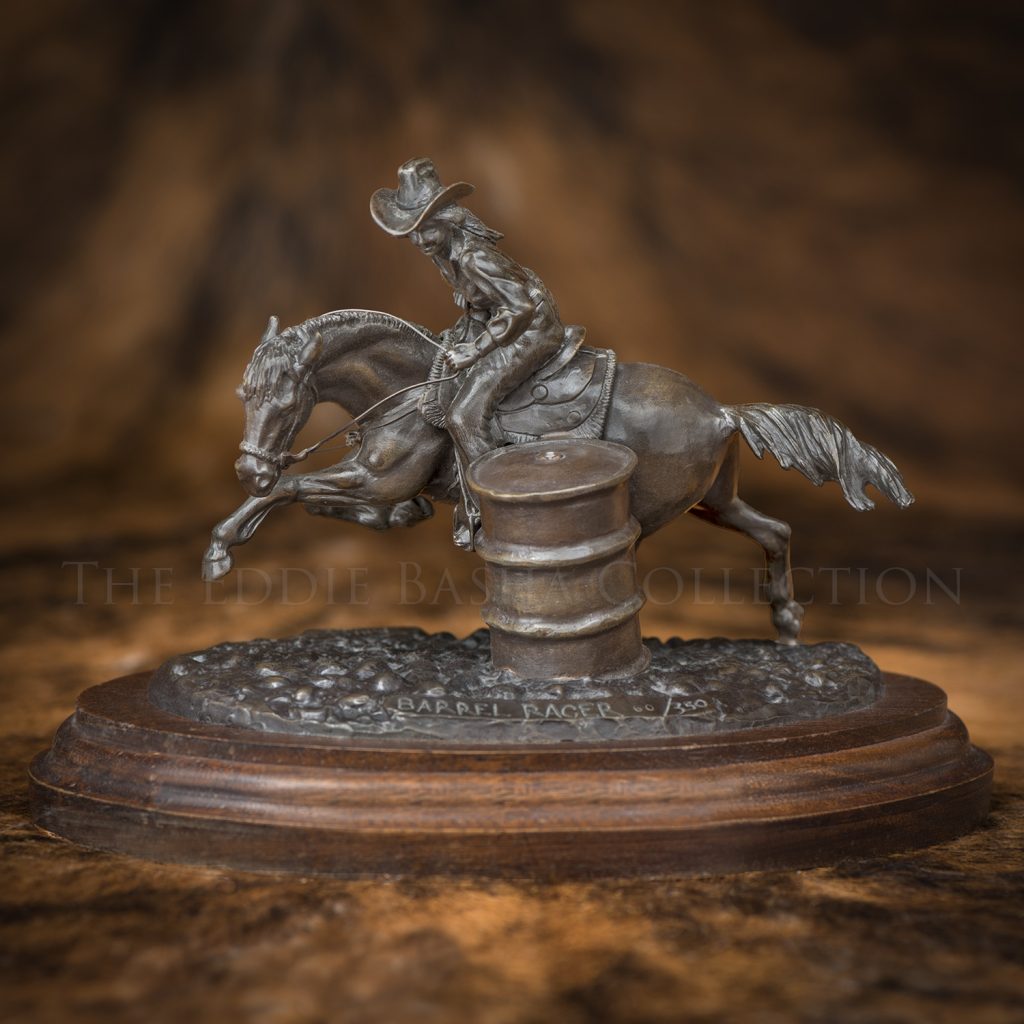 Bronze | Dimensions: 5”h x 7”w x 5 ½”d; Edition #60 of 350
Bronze | Dimensions: 5”h x 7”w x 5 ½”d; Edition #60 of 350Enjoy another of the 1978 Don Polland “The Seven Events of Rodeo” bronze series … “Barrel Racer”.
Per Wikipedia, Barrel racing is a rodeo event in which a horse and rider attempt to run a cloverleaf pattern around preset barrels in the fastest time. Though both sexes compete at amateur and youth levels, in collegiate and professional ranks, it is usually a women's event. It requires a combination of the horse's athletic ability and the horsemanship skills of a rider in order to safely and successfully maneuver the horse around three barrels placed in a triangle pattern within a large arena.
Barrel racing originally developed as an event for women. In early barrel racing, the pattern alternated between a figure-eight and a cloverleaf pattern. The figure-eight was eventually dropped in favor of the more difficult cloverleaf.
It is believed that competitive barrel racing was first held in Texas. The Women's Professional Rodeo Association (WPRA) was founded in 1948 by a group of women from Texas who were trying to find a place for women in the wider sport of rodeo. When it began, the WPRA was called the Girls Rodeo Association (GRA). It consisted of 74 members, with about 60 approved tour events. The Girls Rodeo Association was the first body of rodeo developed specifically for women. The GRA changed its name to Women's Professional Rodeo Association in 1981, and the WPRA still provides women competition opportunities in several rodeo events, but barrel racing remains the most popular.
Barrel Racer (Seven Events of Rodeo Series)
Artist: Donald Polland (1932-2003)
Description:
Bronze | Dimensions: 5”h x 7”w x 5 ½”d; Edition #60 of 350
Enjoy another of the 1978 Don Polland “The Seven Events of Rodeo” bronze series … “Barrel Racer”.
Per Wikipedia, Barrel racing is a rodeo event in which a horse and rider attempt to run a cloverleaf pattern around preset barrels in the fastest time. Though both sexes compete at amateur and youth levels, in collegiate and professional ranks, it is usually a women's event. It requires a combination of the horse's athletic ability and the horsemanship skills of a rider in order to safely and successfully maneuver the horse around three barrels placed in a triangle pattern within a large arena.
Barrel racing originally developed as an event for women. In early barrel racing, the pattern alternated between a figure-eight and a cloverleaf pattern. The figure-eight was eventually dropped in favor of the more difficult cloverleaf.
It is believed that competitive barrel racing was first held in Texas. The Women's Professional Rodeo Association (WPRA) was founded in 1948 by a group of women from Texas who were trying to find a place for women in the wider sport of rodeo. When it began, the WPRA was called the Girls Rodeo Association (GRA). It consisted of 74 members, with about 60 approved tour events. The Girls Rodeo Association was the first body of rodeo developed specifically for women. The GRA changed its name to Women's Professional Rodeo Association in 1981, and the WPRA still provides women competition opportunities in several rodeo events, but barrel racing remains the most popular.
bronzeEnjoy another of the 1978 Don Polland “The Seven Events of Rodeo” bronze series … “Barrel Racer”.
Per Wikipedia, Barrel racing is a rodeo event in which a horse and rider attempt to run a cloverleaf pattern around preset barrels in the fastest time. Though both sexes compete at amateur and youth levels, in collegiate and professional ranks, it is usually a women's event. It requires a combination of the horse's athletic ability and the horsemanship skills of a rider in order to safely and successfully maneuver the horse around three barrels placed in a triangle pattern within a large arena.
Barrel racing originally developed as an event for women. In early barrel racing, the pattern alternated between a figure-eight and a cloverleaf pattern. The figure-eight was eventually dropped in favor of the more difficult cloverleaf.
It is believed that competitive barrel racing was first held in Texas. The Women's Professional Rodeo Association (WPRA) was founded in 1948 by a group of women from Texas who were trying to find a place for women in the wider sport of rodeo. When it began, the WPRA was called the Girls Rodeo Association (GRA). It consisted of 74 members, with about 60 approved tour events. The Girls Rodeo Association was the first body of rodeo developed specifically for women. The GRA changed its name to Women's Professional Rodeo Association in 1981, and the WPRA still provides women competition opportunities in several rodeo events, but barrel racing remains the most popular.
 Bronze | Dimensions: 7”h x 8”w x 5”d; Edition #60 of 350
Bronze | Dimensions: 7”h x 8”w x 5”d; Edition #60 of 350In 1978, Don Polland began a miniature series of bronze pieces entitled “The Seven Events of Rodeo” of which “Steer Wrestling” is one piece within the series. Each within the series is titled, bears the artist’s signature, the year and its edition number. And though Polland’s bronzes are quite small, they contain myriad detail and realistic touches that show his familiarity with his subject matter.
Steer Wrestling (Seven Events of Rodeo Series)
Artist: Donald Polland (1932-2003)
Description:
Bronze | Dimensions: 7”h x 8”w x 5”d; Edition #60 of 350
In 1978, Don Polland began a miniature series of bronze pieces entitled “The Seven Events of Rodeo” of which “Steer Wrestling” is one piece within the series. Each within the series is titled, bears the artist’s signature, the year and its edition number. And though Polland’s bronzes are quite small, they contain myriad detail and realistic touches that show his familiarity with his subject matter.
bronzeIn 1978, Don Polland began a miniature series of bronze pieces entitled “The Seven Events of Rodeo” of which “Steer Wrestling” is one piece within the series. Each within the series is titled, bears the artist’s signature, the year and its edition number. And though Polland’s bronzes are quite small, they contain myriad detail and realistic touches that show his familiarity with his subject matter.
 Bronze (Miniature) | Dimensions: 5”h x 13”w x 8’d; Edition #10 of 60
Bronze (Miniature) | Dimensions: 5”h x 13”w x 8’d; Edition #10 of 60This scene was played out often in the wild, rugged west by an unscrupulous cast of characters.
Border Rustlers
Artist: Donald Polland (1932-2003)
Description:
Bronze (Miniature) | Dimensions: 5”h x 13”w x 8’d; Edition #10 of 60
This scene was played out often in the wild, rugged west by an unscrupulous cast of characters.
bronzeThis scene was played out often in the wild, rugged west by an unscrupulous cast of characters.
 Bronze (1975) | 5”h x 6”w; Edition #2 of 6
Bronze (1975) | 5”h x 6”w; Edition #2 of 6Paintin’ the Town
Artist: Donald Polland (1932-2003)
Description:
Bronze (1975) | 5”h x 6”w; Edition #2 of 6
bronze Bronze (1976) | Dimensions: 3 ½”h X 6 ½”w X 4”d; Edition #15 of 35
Bronze (1976) | Dimensions: 3 ½”h X 6 ½”w X 4”d; Edition #15 of 35Small bronzes were a specialty of Donald Polland, and though small in size they are no less detailed than a larger bronze. “Looking for Trouble” is an excellent study of western wildlife. Mountain Lion often prey upon javelina though not always successfully. Javelina won’t necessarily back down nor run away since they have a tendency to travel in large family packs and are well equipped to fight with their long, sharp and protruding canine teeth.
Looking for Trouble
Artist: Donald Polland (1932-2003)
Description:
Bronze (1976) | Dimensions: 3 ½”h X 6 ½”w X 4”d; Edition #15 of 35
Small bronzes were a specialty of Donald Polland, and though small in size they are no less detailed than a larger bronze. “Looking for Trouble” is an excellent study of western wildlife. Mountain Lion often prey upon javelina though not always successfully. Javelina won’t necessarily back down nor run away since they have a tendency to travel in large family packs and are well equipped to fight with their long, sharp and protruding canine teeth.
bronzeSmall bronzes were a specialty of Donald Polland, and though small in size they are no less detailed than a larger bronze. “Looking for Trouble” is an excellent study of western wildlife. Mountain Lion often prey upon javelina though not always successfully. Javelina won’t necessarily back down nor run away since they have a tendency to travel in large family packs and are well equipped to fight with their long, sharp and protruding canine teeth.